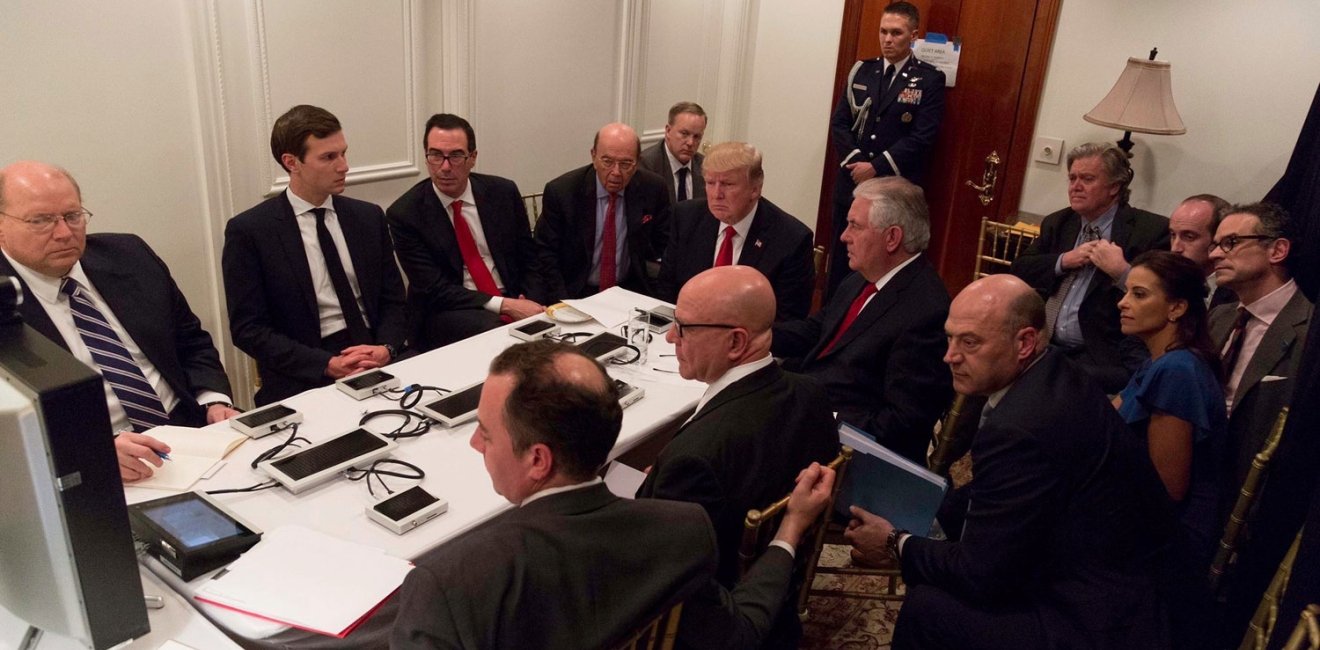Tomahawk missiles fired late Thursday by the U.S. Navy at a Syrian airbase have put an end to the entire setup of the Russian-American relations of the Obama years. The U.S. has effectively turned the page on its de-facto absence from the Syrian conflict and Russia’s stint as the only major world power willing to use force in the region.
The change promises to be unfavorable for both the U.S. and Russia. Both countries’ political leaders have their reasons to stay on course with their conflicting views of the situation in the region. A political dynamic may form that would make both the White House and the Kremlin escalate their involvement in the conflict zone, almost against their will.
Russia’s first official reaction to the pre-dawn strike was to condemn it as “an aggression against a sovereign state in violation of international law.” President Trump ordered the strikes under a “far-fetched pretext,” Russian President Vladimir Putin’s spokesman Dmitry Peskov said in a statement.
Russia also said it would suspend deconfliction agreements, a military to military coordination system that prevents both countries’ warplanes from coming into collision over the conflict zone. This is puzzling because it is due to such an agreement that the Russian military was notified about the Thursday strikes.
It is highly unlikely that Putin would decide to back down from standing behind Syria’s embattled dictator Bashar al-Assad, despite the spiralling costs of such support. The Russian military will now take steps to strengthen Syrian air defences to help “protect the most sensitive Syrian infrastructure facilities,” Major General Igor Konashenkov, spokesman for the Russian Defence Ministry, said on Friday.
Even a few days ago, the Kremlin was not anticipating direct U.S. involvement in the Syrian conflict. In fact, it is still unclear whether the U.S. strikes on Thursday represent a fundamental policy shift toward Syria. Many commentators see the attack as a one-off, an almost inevitable response to the Syrian regime’s use of banned chemical weapons against civilians.
If Trump followed his own tune on Syria, he would have been compared to Obama!
“Such a one-off strike is unlikely to be militarily decisive, even if it has made a real dent in the Assad regime’s airpower advantage,” Mark Galeotti, a senior researcher at the Institute of International Relations in Prague, wrote on his blog early on Friday.
The U.S. has hardly been consistent in its Syria policy. President Donald Trump went from a refusal to pursue an ouster of Assad, to a military strike against him in the space of just one week.
About a week ago, during his trip to Turkey, U.S. Secretary of State Rex Tillerson echoed the Russian policy line in saying that the “longer-term status of President Assad will be decided by the Syrian people.” In fact, if there ever was a Trump position on Syria, it was about staying out of the fight against the Assad regime and concentrating on destroying ISIS instead.
A gas attack, on Tuesday, against the city of Idlib appeared to have changed Trump’s disposition toward Assad. “My attitude toward Syria and Assad has changed very much,” he said in an emotional statement on Wednesday.
It is highly unlikely that the reasons for Trump’s about-face on Syria were solely emotional. Too many factors precluded him from sticking to the original stay-out mantra. Too many important Republicans derided President Obama for his inaction on Syria back in 2013. The paradox of highly partisan politics is that although Trump himself was against military strikes in 2013, his inaction in 2017 would cost him dearly.
“One day we’re bombing Libya and getting rid of a dictator to foster democracy for civilians, the next day we are watching the same civilians suffer while that country falls apart,” Trump said in April 2016. “We’re a humanitarian nation. But the legacy of the [former President Barack] Obama [and former Secretary of State Hillary] Clinton interventions will be weakness, confusion and disarray.”
If Trump followed his own tune on Syria, he would have been compared to Obama! A significant portion of his current political base would have aligned with many Democrats in accusing the president of betraying weakness in the face of a murderous tyrant.
Both America and Russia are ruled by self-proclaimed pragmatists, but both of these supposed pragmatists have proven to be extremely thin-skinned and sensitive to being portrayed as weak. This is an ancient path toward conflict.
And not just a murderous tyrant, but his cunning backer from Moscow. The Trump administration’s developing Russia problem would have made it practically impossible for the president to keep clear of Syria. Given the highly publicized and emotionally charged nature of the deadly gas attack, a failure to respond to would have been immediately portrayed as a confirmation of Trump’s collusion with the Kremlin.
The administration’s Russia story threatened to overshadow all policy initiatives the Trump team was pushing for. Putting an end to the story was clearly one of the major priorities of the U.S. administration.
Last but not least, Trump’s approval rating hit 36 percent last week, the lowest of any recorded president in their first year in office. As any Russian observer would confirm, we in Russia are tired of watching the Kremlin’s obsession with the president’s approval rates. If public support is seen as crucial, leaders of a certain type would do anything to prop it up. Both Trump and Putin seem to be that type of leader. For years, Putin has used foreign policy to bolster his domestic ratings. These days, both countries’ foreign policies risk being driven by domestic concerns.
A dynamic may be established between the United States and Russia that would push both countries in the direction of further escalation. Both America and Russia are ruled by self-proclaimed pragmatists, but both of these supposed pragmatists have proven to be extremely thin-skinned and sensitive to being portrayed as weak. This is an ancient path toward conflict. Every sensible leader of the international community has a responsibility to help the two countries return to dialogue.
The opinions expressed here are solely those of the author.







